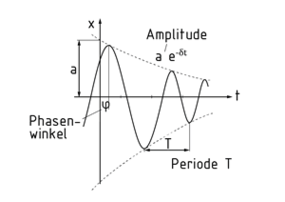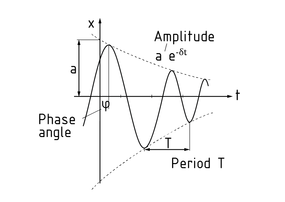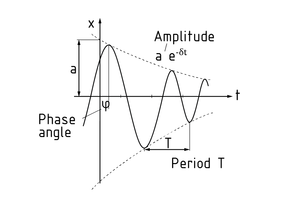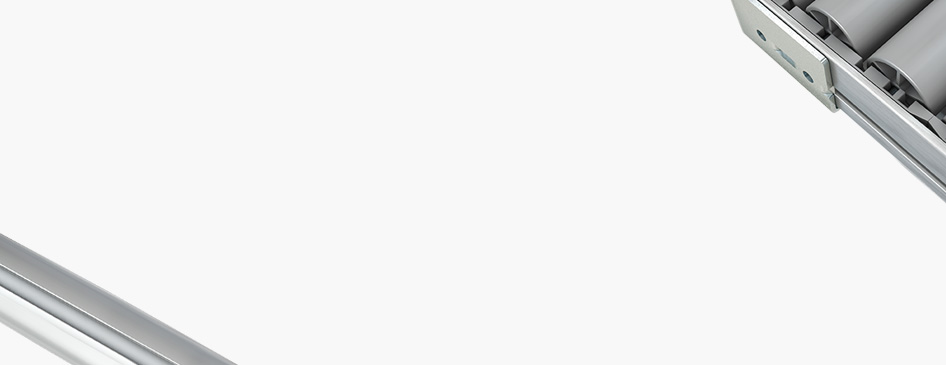
Choose one
or multiple languages
0,1,1
- German
- English
- Chinese
- Spanish
Damping

Damping is the attenuation of oscillations brought about by a continuous loss of energy. Following excitation, oscillatory systems (oscillators) continuously oscillate between two forms of energy (in the case of mechanical Oscillation, for example, kinetic and potential energy). If dissipative forces occur, the oscillations are damped. For example, if energy is removed from the system in a third form (such as heat), the oscillation's amplitude continuously decreases and subsides. Even if energy is fed into a real oscillatory system on an ongoing basis, the continuous emission of heat (due to friction) results in oscillations being damped.
If damping exceeds a critical value, the system no longer oscillates but returns to its original position (state of Equilibrium) after a time.
In real oscillators, the damping Force is often proportional to the Velocity. The amplitude then decreases exponentially.
Damping can occur in several forms due to:
- Material properties (material damping)
- The Design of the oscillatory system (system damping)
- The properties and quality of the bearings (Bearing damping, frictional damping)
- Environmental conditions, if the system is not oscillating in a vacuum (environmental damping)
- Oscillation (vibration) dampers if damping is desirable (e.g. shock absorbers in cars)
Dämpfung

Als Dämpfung wird die Abschwächung von Schwingungen beschrieben, die durch einen fortlaufenden Energieverlust hervorgerufen wird. Schwingfähige Systeme (Oszillatoren) pendeln nach einer Anregung fortlaufend zwischen zwei Energieformen hin und her (Bei einer mechanischen Schwingung sind dies beispielsweise Kinetische Energie und potentielle Energie.). Treten dissipative Kräfte auf, werden die Schwingungen gedämpft: Wird dem System beispielsweise Energie in einer dritten Energieform (wie Wärme) entzogen, wird die Amplitude der Schwingung fortlaufend kleiner und verebbt. Auch wenn einem realen Schwingungssystem fortlaufend Energie zugeführt wird, werden Schwingungen gedämpft, indem kontinuierlich Wärme (durch Reibung) abgegeben wird.
Übersteigt die Dämpfung einen kritischen Wert, oszilliert das System nicht mehr, sondern kehrt nach einiger Zeit in seine Ausgangslage (Gleichgewichtslage) zurück.
In realen Oszillatoren ist die dämpfende Kraft häufig proportional zur Geschwindigkeit. Die Amplitude nimmt dann exponentiell ab.
Dämpfung kann in mehreren Formen stattfinden durch:
- Eigenschaften des Materials (Materialdämpfung)
- Konstruktion des Schwingsystems (Systemdämpfung)
- Beschaffenheit und Güte der Lager (Lagerdämpfung, Reibungsdämpfung)
- Umgebungsbedingungen, wenn das System nicht im Vakuum schwingt (Umgebungsdämpfung)
- Schwingungsdämpfer, wenn Dämpfung erwünscht ist (etwa Stoßdämpfer im Auto)
阻尼

阻尼 是由于能量的持续衰减所造成的振荡衰减。在系统被触发之后,某个振荡系统(振荡器)会连续地在两种形式的能量之间进行转换(例如,如果发生的是机械振动,系统会在动能和势能之间进行转换)。如果系统中出现耗散力,振荡就会由于阻尼而衰减。例如,如果系统中的能量以第三种形式离开系统(比如以发热),那么,振荡的幅度将逐渐减小并消退。即使人们向某个实际振荡系统持续输入能量,然而,由于热量的连续散发(摩擦发热的原因),结果还会造成振荡由于阻尼而衰减。
如果阻尼超过临界值,那么该系统将不再振荡,并会在一段时间后返回其初始位置(平衡状态)。
在实际振荡器中,阻尼的大小往往是与速度成正比的。这样一来,振幅将成指数形式减小。
由于以下因素,阻尼可产生几种形式:
材料特性(材料阻尼)
振荡系统的设计(系统阻尼)
承载物的特性和质量(承载物的阻尼,摩擦阻尼)
环境条件,除非是发生在真空中的振荡(环境阻尼)
如果人们需要使用阻尼(例如,汽车减震器),则振荡(振动)减震器。
阻尼,周期性振荡
Amortiguación

La amortiguación es la atenuación de las oscilaciones provocadas por una pérdida continua de energía. Después de la excitación, los sistemas oscilatorios (osciladores) oscilan continuamente entre dos formas de energía (en el caso de la oscilación mecánica, por ejemplo, la energía cinética y la potencial). Si hay fuerzas de disipación, las oscilaciones se amortiguan. Por ejemplo, si se remueve energía del sistema en una tercera forma (como calor), la amplitud de la oscilación disminuye continuamente. Incluso si se alimenta energía a un sistema oscilatorio real de manera continua, la emisión continua de calor (debido a la fricción) resulta en una disminución de las oscilaciones.
Si el amortiguamiento excede un valor crítico, el sistema ya no oscilará, sino que regresará a su posición original (estado de equilibrio) después de un tiempo.
En los osciladores reales, la fuerza de amortiguamiento es a menudo proporcional a la velocidad. La amplitud luego disminuye exponencialmente.
La amortiguación puede ocurrir de diversas maneras debido a:
Las propiedades del material (amortiguamiento del material)
El diseño del sistema oscilatorio (amortiguamiento del sistema)
Las propiedades y la calidad de los rodamientos (amortiguamiento de rodamientos, amortiguamiento por fricción)
Las condiciones ambientales, si el sistema no oscila en vacío (amortiguamiento ambiental)
Los amortiguadores de oscilación (vibración) si se desea un amortiguamiento (por ejemplo, parachoques en los autos)
Oscilación periódica amotiguada
